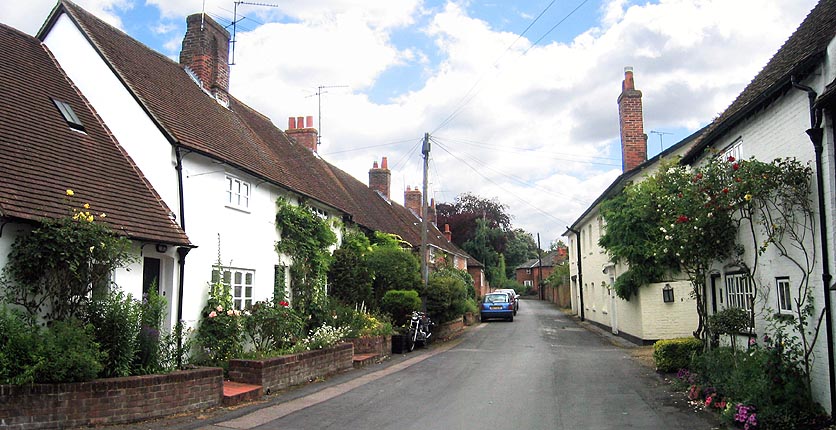 |
 |
|||
|
|
The Saxon place-name is
usually said to mean 'Dunna's People's Town'. However, like Donnington
in Gloucestershire, this Berkshire village may derive its name from Dunnan-Straet-Tun
or 'Dunna's Street Town' referring to the Roman Ermin(e) Way which
passes through the parish. Donnington is best known
for its castle and
the village has witnessed many fascinating events connected with it.
From early times, the Abberbury family owned the manor and it was to Sir
Richard Abberbury the Elder that King Richard II first granted a
license to crenellate his house there in 1386. This included the
building of the present gatehouse. Abberbury had been one of the young
King’s guardians in his youth and later became Chamberlain to his
wife, Queen Anne. Donnington has no parish church in the village. It
stands at Shaw, but the
parish is known as Shaw-cum-Donnington. There was once an old chapel at Donnington
but, rather than
rebuild it, Abberbury gave it to the Friars of St. Cross who founded a
Friary there around 1376. It served the local community until its
dissolution in 1538. Abberbury was also lord of the manor of Iffley in
Oxfordshire which, in 1393, was given to support the founding of the Donnington
Hospital, a charity providing almshouses for twelve poor men. It
is the oldest charity in Berkshire and the 23rd oldest in the country! Donnington Castle was later
bought by Thomas Chaucer, son
of the poet. He was also Constable of Wallingford
Castle, and his main residence was at Ewelme in Oxfordshire; so
Donnington probably saw little of its new lord. He did, however, take an
interest in the almshouses and built his own, at Ewelme, on the
Donnington model. By Tudor times, the castle had fallen into Royal hands
and members of the Royal family sometimes visited. Their retainers no
doubt filled all available accommodation in the village as well as the
castle. On one occasion temporary dwellings had to be erected for them.
King Henry VIII came in 1539 and 1541. Perhaps he wanted to scotch the
rumours perpetuated by a Donnington Almsman that he was dead. The poor
man was pilloried in Newbury and
subsequently had his ears cut off! Princess Elizabeth was granted the
castle by her brother but her sister, when Queen, would not let her live
there. The villagers were kept fully employed when the building was
completely refurbished for her eventual visit, as Queen Elizabeth I, in
1568. She later granted the stewardship to Lady
Hoby of Bisham Abbey
but gave the castle away to the Earl of Nottingham. The Earl let the new
King James house his retinue there whilst on a trip to Shaw
House. Lady Hoby was incensed and took a band of armed clothiers
up to the castle from Newbury . The people of Donnington must have been
terrified as the angry mob marched through the village before being
repulsed at the fortress gates. In 1602, the Earl of
Nottingham refounded the old almshouses which he discovered in a state
of disrepair. The present building on the main road dates from this
time, although they were considerably restored after abandonment during
the Civil War. By this time the castle was owned by the Parliamentarian
Packer family, but, at the commencement of hostilities, it was quickly
taken for the King and held by Sir John
Boys. It was besieged for most of the war and its guns
held off the parliamentary army during the Second
Battle of Newbury. The village was deliberately destroyed by
Boys to stop the Roundheads finding shelter there and, after the war,
there was much rebuilding to do. A ghostly re-enactment of a skirmish
between a Royalist cavalry patrol from the castle and a superior
parliamentary force from the town is sometimes said to still be seen in
Love Lane. The Packers lived mostly at
Shellingford Manor in the north of the county, but, with the destruction
of the castle, their residence when visiting Donnington became the old
steward's lodge, now Donnington Castle
House. In 1699, Robert Packer
married Mary Winchcombe, the eventual heiress of her ancient family
whose estates were centred on Bucklebury
House. Thus the two manors became united, but while the lord of
the manor transferred himself eastward, other great houses began to
emerge in Donnington. The 'Priory,' originally converted from the old
Friary but rebuilt after the Civil War, was the home of the Cowslade
family, including the usher to Queen Charlotte. Donnington
Grove was built for the historian, James
Pettit Andrews in 1763, in Strawberry Hill Gothic style. He
was half-brother of the lord of Shaw
Manor. Twenty years later it was
sold to William Brummell, the father of the King's great friend, Beau.
Around this time, the Packer heiress and her husband, David
Hartley, the famous physician and philosopher, lived at Donnington
Castle House for a whole year and considered making it their permanent
residence, but in the end decided they preferred Bath and London. |
|||
| © Nash Ford Publishing 2004. All Rights Reserved. | ||||




